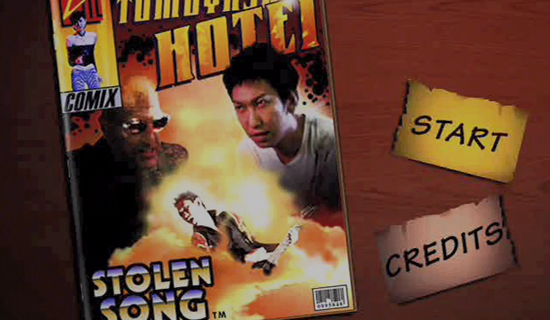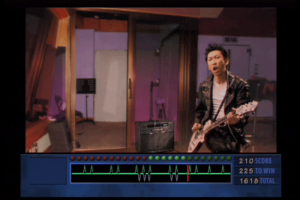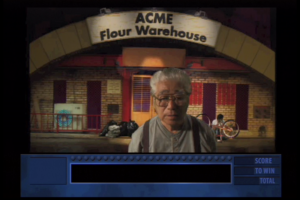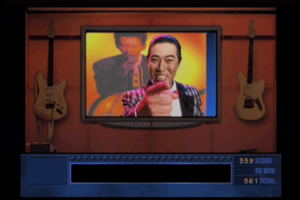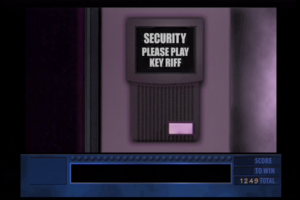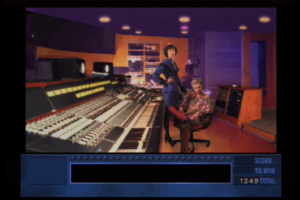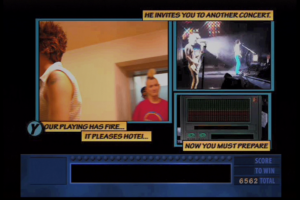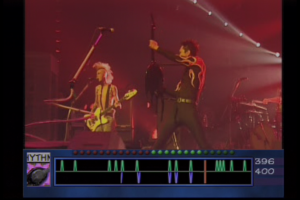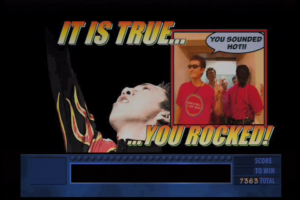Virtual Music Entertainment previously released a game on PlayStation and various home computer OS’ called Quest for Fame, which featured music from the then extremely popular American rock band Aerosmith. Stolen Song uses the same engine as Quest for Fame did, but features legendary Japanese guitarist Tomoyasu Hotei. He may not be so known to western J-rock fans, but is probably best known for “Battle Without Honor or Humanity”. This song was featured in Quentin Tarantino’s movie Kill Bill: Volume 1, but has since been featured in many other films and commercials. And it really can’t be understated just how much of a presence he’s been in Japanese rock for the last few decades.
Hotei made his professional music debut in 1982 as the guitarist of the now extremely influential rock band Boowy. The group featured Kyosuke Himuro on vocals (who would later go on to have his own wildly successful solo career), Tsunematsu Matsui on bass, and Makoto Takahashi on drums. They only lasted until 1988, the most popular rumor as to why they were breaking up being differences between Hotei and Himuro. But by that time they had become so popular that their farewell concert (a two-night affair) was held at the Tokyo Dome. Some members have played together live here and there since breakup, but there’s never been an actual reunion.
Boowy themselves performing “B.Blue”
Hotei performing Boowy’s “Dreamin” at EMI Rocks 2013, along with some notable special guests: Seiji Kameda (Bass), Makoto Takahashi (Drums), Yasuhiro Nozaki (Keyboard), Miyavi (Guitar), Nobuo Ooki of ACIDMAN (Vocals), and Kazuya Yoshii of The Yellow Monkey (though at this time he was solo) (Vocals). This is kind of an unbelievable collaboration!
Boowy’s breakup didn’t slow Hotei down though, as he released his first solo album, Guitarhythm, in October of 1988. He also started a duo with well known rock vocalist Koji Kikkawa called Complex. This was an especially big deal since both members were already well known musicians, and both of the albums they released went to number one on the Oricon charts. Their breakup was rather sudden, with Hotei even reportedly calling the group “a mistake”. For years there was no real public interaction between the two, so bad blood was assumed. However there was a two-night reunion show for Complex back in 2011 at the Tokyo Dome, so things must have worked themselves out over the course of 21 years.
The original music video for probably Complex’s most popular song, “Be My Baby”.
Hotei and Kikkawa reunited in 2011, and performing the same song.
Hotei’s solo career still continues on to date, with a total of 18 studio albums so far. He’s collaborated with a ton of international artists, has resided in London for some time, and has in general achieved the status of rock legend. If a Japanese musician was going to have to be put into a game as a followup to one featuring Aerosmith, Hotei is one of the best choices I can think of.
The rhythm game portion of this is very bare bones: You have a “rhythm EKG” in front of you, and you have to hit a single button (circle on the PlayStation controller) in time to the lines that appear on it. To make things slightly more interesting, the limited edition came with a little known peripheral called the VPick. This larger than normal guitar pick controller is meant to be plugged into the second controller part, and used only for the music portions. Given that you’re only ever using one button on a standard PS controller, the VPick doesn’t really make things much easier. But as far as I know, it’s a peripheral used only for this and Quest for Fame (it was also packed in with that title). Toshiba EMI even published a version of this game for Windows 95 on July 8th of the same year, complete with a version of the VPick that connected through a serial port.
There are also some interesting options to be found in the menu: Guitar sounds can be changed for both rhythm and lead parts between clean electric, distortion, cyber metal, thunder, funky, and acoustic guitar. You also have options to toggle sound levels individually for master volume, instruments, song, and special effects. I’d recommend turning down the instrument volume, because it’s obnoxiously louder than the song tracks by default. Difficulty is an option as well, and since this is a PS1-era rhythm game with pretty strict timing, I couldn’t even get very far on the standard difficulty before I had to lower it. And yes, I was playing it on a CRT!
A very showy performance of “Circus” from the 1997 Space Cowboy Tour.
The parts that aren’t rhythm-based are a goofy FMV game that doesn’t really involve any player interaction. Rather it serves as a way to serve up a basic story, for which all of the footage was filmed in San Francisco. The live performance footage though, is all from Hotei’s 1997 Space Cowboy Tour. The band members featured in the game are also the very same that played with him on that tour: Takeshi Tsuji (Guitar), HIROSHI (Bass), and Kouichirou Naka (Drums). Keyboardist Haruo Togashi also was in the touring band, but was not featured in the game. Hotei’s actual manager and some of his staff even appeared in minor roles.
The story begins with you, a soon to be super guitarist, walking back to your apartment. A Japanese man, who is presumably your landlord, walks up and asks you where the rent is. You promptly ignore him, your money problems are never mentioned again, and you go inside. In your tiny apartment You can interact with the TV to play a commercial for a guitar shop (featuring the game’s villain, but we don’t know that yet), a guitar (which is carelessly sitting on a love seat, even though there are two guitars already mounted on the wall behind it) to just play a lick or two, or the remote to show you what you’re actually here to see: How to enter into the “Battle of Guitarists”. The winner of this contest will be able to record their own demo in Hotei’s private studio! In order to enter, you just have to get a passing score on one of three songs: “inochi wa moyashi tsukusu tame no mono” (12th single, 1996), “SERIOUS?” (from the album Guitarhythm IV, 1994) or “RADIO! RADIO! RADIO!” (B-side from the Beat Emotion single, 1991).
Once you qualify to enter the battle, you’re greeted by some ridiculous TV host that presents the actual contest to you: You must play four short riffs correctly from a list of six, and you aren’t allowed to make more than 3 mistakes during an attempt. After completing them, you’re given the “key” to Hotei’s studio in the form of your own unique riff. Yes, playing this will act as your way to open the door to his “Cyber Studio”.
Here you’re introduced to manager Nina and recording engineer Zino, who speaks in a weird mix of Japanese and English that he also has in common with the villain later on. Though you’re greeted with some suspicion, you go right into the studio to record the demo track that Zino has prepared for you. If you pass, they call in Hotei himself to listen to your demo. He’s so impressed with it that he takes you to hear his new song, and record some of the guitar parts with him. Though it’s never actually called this in-game, this song is titled “Fun3”, and was made specifically for this game. However on B-side compilation “B-Side Rendez-vous” (released in 2000), it appeared as “Fun Fun Fun”. It’s a different version of the song that’s more up-tempo, and doesn’t resemble the version found here all that closely.
You’re then taken to Hotei’s concert that night to perform on stage with him. You don’t get very far in though before some masked men jump up on stage and knock you unconscious. When you wake up, Hotei is gone and everyone’s trying to find out what happened to him. Being the new guy, the band members suspect you. But Nina wants them to give you a chance, so you do what anyone would do: Play some songs with the band members on the rooftop in order to gain their trust! You play a small part of “RADIO! RADIO! RADIO!”, then move on to “I’M FREE” (from the album Guitarhythm III, 1992).
Once you’ve gained their trust through song, you all go down to the studio to talk about how to find Hotei. They suspect information on his whereabouts could be found at a guitar shop/live house called Snakefinger’s, run by a foreigner known only as “Mr. Tommy”. You’re the one who has to go in to plant the bug under the guise of needing some guitar repairs, since Mr. Tommy has never seen you before. Upon arriving, you have to compete with his student Proto in an impromptu guitar showdown. You’re goaded into this by Mr. Tommy in order to get your repair done for free, but no, you can’t just pay for it like a normal person and walk out on Proto.
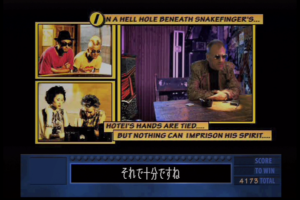
I guess at some point during this you plant the bug, because you’re able to head on back and listen in on what’s going on with Mr. Tommy. And wouldn’t you know it, he’s holding Hotei there in order to steal his new song! His plan is to have Proto play it, so he’ll get a big fat record contract. You all determine that there’s only one way to stop this: You need to get on stage and play the song better than Proto, so you can prove what a fake he is. The rest of the crew will distract Mr. Tommy and find Hotei.
After some time in the studio to rehearse the new song together, you head over to Snakefinger’s and have your showdown with Proto. After you win, he’s coerced into admitting that it was never his song, and Hotei is recovered. Of course Hotei wants you to play another concert with him, so you need to practice “Boys Be Ambitious” (from the album King & Queen, 1996) and “Captain Rock” (also from King & Queen, 1996) to play on stage. After those, you come back out for the encore, which is “Poison” (9th single, 1995). Hotei then introduces you to the crowd, and acknowledges what a great talent you are. And that’s the game!
If you haven’t had enough of Stolen Song after the couple of hours or so it takes to clear, there’s even a 2-player mode where you can choose between guitar and drum parts. This mode only allows you to play “RADIO! RADIO! RADIO!’, “I’M FREE”, and “SERIOUS?” though. I can’t believe too many people would have spent much time on this mode, given how simple the game play is on the scale of rhythm games.
In fact you’ve probably only played this game if you’re an absolute rhythm or FMV game completionist, or a big Hotei fan. As a big Hotei fan myself, the biggest surprise was that there weren’t more singles included in the song list (though “inochi wa moyashi tsukusu tame no mono” and “Poison” were both singles). Assuming that they started working on the game in 1997, songs “Thrill”, “Last Scene”, “saraba seishun no hikari”, “Beat Emotion”, “Circus”, etc. would already have been released. At any rate, it’s fun to see Hotei involved in something like this, but a lot of that fun is found in the FMV portions rather than the rhythm game portions. And I suspect that’s only fun if you’re a fan, or love campy FMV.
Kazuya Yoshii and Hotei performing “Thrill” together on “Our Music”, a TV program that features collaborations between artists.
